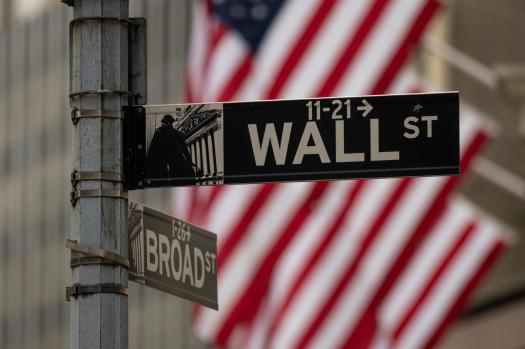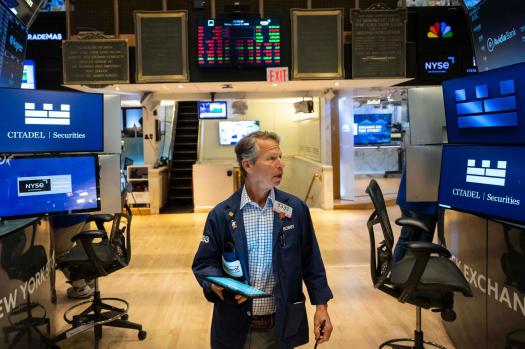By AP Business Writer Stan Choe
NEW YORK (AP) The stock market in the United States is on the verge of setting yet another record.
Related Articles
-
US economy shrank 0.5% between January and March, worse than 2 earlier estimates had revealed
-
People on the move
-
SpaceX Crew Dragon with 4 Axiom Space astronauts docks with space station
-
Kennedy Space Center goes retro for Y2K after-hours event
-
Ask a real estate pro: Can we stop a resident from smoking on the balcony?
In early trade, the S&P 500 was up 0.4% and only 0.5% from its peak, which was reached in February. At 9:35 a.m. Eastern time, the Nasdaq composite was up 0.4% and the Dow Jones Industrial Average was up 207 points, or 0.5%.
Cooking spice vendor McCormick led the charge and saw a 5.3% increase following the release of a higher-than-expected profit report. The company also exceeded analysts’ estimates with its profit prediction for the entire fiscal year, which included plans to offset higher costs brought on by President Donald Trump’s tariffs.
Longer term, large technology stocks have dominated the market for years, and since the S&P 500 dropped almost 20% from its peak in the spring due to concerns about tariffs.
Computer memory and data storage manufacturer Micron Technology had a 0.3% increase in stock price on the release of higher-than-expected profit and sales for the most recent quarter. According to CEO Sanjay Mehrotra, the company’s profit projection for the current quarter exceeded analysts’ forecasts, and it is witnessing an increase in memory demand driven by artificial intelligence.
Chip CompanyWith a 0.5% increase, Nvidia, the face of the AI craze, increased its annual gain to 15.3%. On the American stock exchange, it is the most valued firm.
Since the president stunned the globe in April with his harsh proposed levies, Wall Street’s concerns about Trump’s tariffs have subsided, but they haven’t gone away. The final size of the tariffs, their impact on the economy, and their potential to increase inflation are still unknown.
The economy appears to be doing well thus far, and additional data was released on Thursday to support that. According to one, orders for manufactured products that endure at least three years, such as washing machines, increased last month more than experts had predicted. According to a second, fewer American workers applied for unemployment insurance last week, which may indicate fewer layoffs.
According to a third analysis, the U.S. economy shrank more in the first three months of 2025 than previously thought. However, a lot of experts claim that those figures were skewed since so many American businesses hurried to purchase goods from overseas this year before tariffs were imposed, and they anticipate stronger growth in the months to come.
Treasury yields fluctuated in the bond market after the stories, but they didn’t move much in the end.
Late Wednesday, the yield on the 10-year Treasury dropped from 4.29% to 4.26%. The yield on the two-year Treasury, which more accurately reflects expectations for the actions of the Federal Reserve, decreased slightly from 3.74% to 3.73%.
According to a Wall Street Journal article, Trump may name his pick to succeed Fed Chair Jerome Powell unusually early in an effort to discredit Powell, which analysts claimed could be driving rates lower.
Powell has reiterated recently that the Federal Reserve is delaying a decision on when to start reducing interest rates until it has seen how tariffs will impact the economy. This year, it has been put on hold because lower rates can improve the economy and possibly fuel inflation.
However, Trump has regularly attacked Powell and has been emphatic about wanting rate decreases sooner. Recently, two of his Fed appointees stated that they would think about lowering interest rates as soon as the Fed meets again in approximately a month.
According to Brian Jacobsen, chief economist at Annex Wealth Management, yields declined, the currency depreciated, and break-evens increased, all of which indicated that a White House puppet in the Chair position may be detrimental to inflation. However, Jacobsen stated that a committee of Fed officials, not only the chair, would still make interest rate decisions and that other officials could be able to hold the new leader accountable if necessary.
Indexes in foreign stock markets were mixed over a large portion of Asia and Europe.
Two of the most significant movements were the 1.6% increase in Japan’s Nikkei 225 and the 0.9% decline in South Korea’s Kospi.
After falling by almost $10 per barrel earlier this week, crude prices gained some ground in the oil market, which has seen a lot of activity this week. Benchmark U.S. crude oil prices increased 1% to $65.55, although they are still lower than they were at the start of Israel’s war with Iran.
Elaine Kurtenbach, an AP Business Writer, made a contribution.












